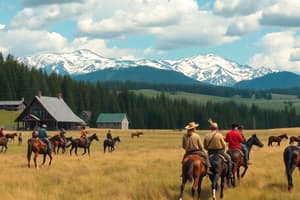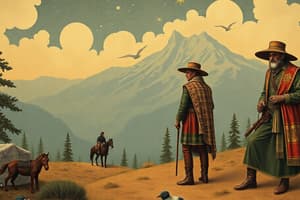Podcast
Questions and Answers
What was the primary goal of Abraham Lincoln at the beginning of the Civil War?
What was the primary goal of Abraham Lincoln at the beginning of the Civil War?
- Preserve the Union (correct)
- Emancipation of enslaved people
- Expansion of slavery
- Establishing a new government
Which amendment provided equal protection under the law to all persons born in the U.S.?
Which amendment provided equal protection under the law to all persons born in the U.S.?
- 14th Amendment (correct)
- 13th Amendment
- 15th Amendment
- 16th Amendment
What was one of the main repercussions of the suspension of habeas corpus during the Civil War?
What was one of the main repercussions of the suspension of habeas corpus during the Civil War?
- Decreased dissent
- Increased military recruitment
- Enhanced civil liberties
- Criticism regarding civil liberties (correct)
Which of the following was a key feature of the Republican Party's platform on slavery?
Which of the following was a key feature of the Republican Party's platform on slavery?
What significant military strategy did General Sherman employ during his march through Georgia?
What significant military strategy did General Sherman employ during his march through Georgia?
What was the purpose of the Freedmen’s Bureau established during Reconstruction?
What was the purpose of the Freedmen’s Bureau established during Reconstruction?
The 10% Plan allowed Southern states to rejoin the Union under which condition?
The 10% Plan allowed Southern states to rejoin the Union under which condition?
Which group favored harsh Reconstruction policies and aimed to protect the rights of freedmen?
Which group favored harsh Reconstruction policies and aimed to protect the rights of freedmen?
What was the primary belief driving Manifest Destiny?
What was the primary belief driving Manifest Destiny?
What was the significance of the slogan '54-40 or Fight!'?
What was the significance of the slogan '54-40 or Fight!'?
What conflict did Bleeding Kansas illustrate?
What conflict did Bleeding Kansas illustrate?
What was a key outcome of the Kansas-Nebraska Act of 1854?
What was a key outcome of the Kansas-Nebraska Act of 1854?
Which provision was included in the Compromise of 1850?
Which provision was included in the Compromise of 1850?
What was the impact of Uncle Tom's Cabin written by Harriet Beecher Stowe?
What was the impact of Uncle Tom's Cabin written by Harriet Beecher Stowe?
What was the main goal of the Know-Nothing Party in the 1850s?
What was the main goal of the Know-Nothing Party in the 1850s?
What was the result of the Dred Scott decision in 1857?
What was the result of the Dred Scott decision in 1857?
Flashcards
Manifest Destiny
Manifest Destiny
The belief that the United States had a God-given right to expand westward across North America.
54-40 or Fight!
54-40 or Fight!
The slogan used by expansionists who wanted the U.S. to claim the entire Oregon Territory up to latitude 54°40′. It ultimately led to a compromise where the U.S. and Britain agreed on the 49th parallel as the border.
Bleeding Kansas
Bleeding Kansas
Violent conflicts between pro-slavery and anti-slavery settlers in Kansas after the Kansas-Nebraska Act. The act allowed for popular sovereignty, leading to divisions and bloodshed.
Kansas-Nebraska Act (1854)
Kansas-Nebraska Act (1854)
Signup and view all the flashcards
Compromise of 1850
Compromise of 1850
Signup and view all the flashcards
Uncle Tom's Cabin (1852)
Uncle Tom's Cabin (1852)
Signup and view all the flashcards
Know-Nothing Party
Know-Nothing Party
Signup and view all the flashcards
Homestead Act (1862)
Homestead Act (1862)
Signup and view all the flashcards
Republican Party's Stance on Slavery
Republican Party's Stance on Slavery
Signup and view all the flashcards
Lincoln's Primary Goal in the Civil War
Lincoln's Primary Goal in the Civil War
Signup and view all the flashcards
Emancipation Proclamation
Emancipation Proclamation
Signup and view all the flashcards
Suspension of Habeas Corpus
Suspension of Habeas Corpus
Signup and view all the flashcards
North's Civil War Advantages
North's Civil War Advantages
Signup and view all the flashcards
Civil War Conscription
Civil War Conscription
Signup and view all the flashcards
Sherman's March to the Sea
Sherman's March to the Sea
Signup and view all the flashcards
Lincoln's 10% Plan
Lincoln's 10% Plan
Signup and view all the flashcards
Study Notes
Manifest Destiny
- Belief that the US had a God-given right to expand westward.
- Driven by nationalism, economic opportunity, and racial/cultural superiority.
- Led to increased sectional tensions over slavery in new territories.
54-40 or Fight!
- Slogan related to the Oregon boundary dispute with Britain.
- Expansionists wanted the US to claim the entire Oregon Territory (54°40′).
- Compromise: US and Britain agreed on the 49th parallel in 1846.
Bleeding Kansas
- Violence between pro-slavery and anti-slavery settlers in Kansas after the Kansas-Nebraska Act.
- Demonstrated the sectional conflict caused by "popular sovereignty".
- Highlighted the deepening division between the North and South.
Kansas-Nebraska Act (1854)
- Proposed by Stephen Douglas to allow popular sovereignty in Kansas and Nebraska territories.
- Repealed the Missouri Compromise of 1820.
- Increased tensions and contributed to the creation of the Republican Party.
Compromise of 1850
- Attempted to reduce tensions over slavery after the Mexican-American War.
- Key elements: California admitted as a free state, stricter Fugitive Slave Law, and abolished the slave trade in Washington D.C.
- Popular sovereignty applied to Utah and New Mexico.
Uncle Tom's Cabin (1852)
- Written by Harriet Beecher Stowe.
- Depicted the harsh reality of slavery, influencing abolitionist sentiment in the North.
Know-Nothing Party
- Anti-immigrant and anti-Catholic political party.
- Emerged in reaction to increased Irish and German immigration.
Homestead Act (1862)
- Offered 160 acres of free land to settlers who agreed to farm and improve the land for five years.
- Encouraged westward migration.
Harpers Ferry Raid (1859)
- Led by John Brown in Virginia.
- Aim was to incite a slave rebellion.
- Brown was captured and executed, becoming a martyr to the abolitionist movement.
Dred Scott Decision (1857)
- Supreme Court ruling by Chief Justice Taney.
- Declared enslaved people were not citizens and that Congress couldn't ban slavery in territories.
- Invalidated the Missouri Compromise.
Election of 1860
- Abraham Lincoln (Republican) was elected without Southern electoral votes.
- Triggered Southern secession, leading to the Civil War.
Republican Party's Platform on Slavery
- Opposed the expansion of slavery into new territories.
- Supported the free soil ideology.
Lincoln's Goal at the Start of the Civil War
- Primary goal was to preserve the Union, not initially focused on ending slavery.
- Later, emancipation became a significant objective.
Emancipation Proclamation (1863)
- Issued after the Union victory at Antietam.
- Freed enslaved people in rebelling Confederate states.
Suspension of Habeas Corpus
- Lincoln suspended the right of habeas corpus during the Civil War to maintain order and loyalty.
- Highly controversial due to limiting civil liberties.
Civil War: North's Advantages
- Larger population, industrial base, and transportation networks.
- Strong central government and navy.
Conscription (Draft)
- First draft implemented in the South (1862), then in the North (1863).
- Led to backlash and violence, including the New York City Draft Riots.
Sherman's March to the Sea (1864)
- General William T. Sherman's military campaign through Georgia.
- Example of total war, aimed at destroying Southern resources and morale.
10% Plan (Reconstruction Plan)
- Lincoln's lenient Reconstruction approach.
- Southern states could rejoin the Union if 10% of their voters pledged loyalty and accepted emancipation.
Radical Republicans
- Favored strict Reconstruction policies.
- Sought to protect freedmen's rights and punish the South.
14th Amendment
- Granted citizenship to all persons born in the US, including formerly enslaved people.
- Provided equal protection under the law.
15th Amendment
- Guaranteed voting rights regardless of race, color, or previous condition of servitude.
- Did not initially address gender.
Freedmen's Bureau
- Established to assist formerly enslaved people in adjusting to freedom.
- Provided education, healthcare, and employment assistance.
Studying That Suits You
Use AI to generate personalized quizzes and flashcards to suit your learning preferences.




